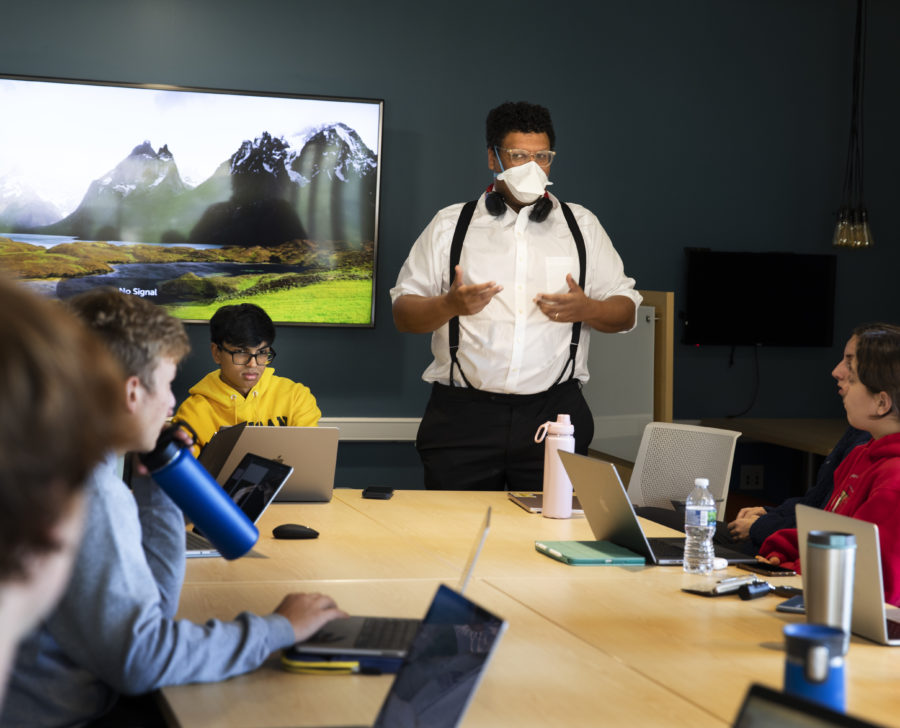Engineering for Social Impact: Making a Better World
Every Wednesday this semester, the Center for Socially Engaged Design (C-SED) is bustling with first-year engineering students. Students can either be found with their heads together in small groups working in the C-SED Collaboration Space or peering through matching safety glasses in the C-SED Lab.
Story by Lawryn Fraley
Taking an Engineering 100 course is a universal experience for all engineering students and is meant to introduce first-years to basic engineering design concepts, principles, and methods; give them contextualized instruction and experience in technical communication; and to acquaint students with important concepts in engineering ethics, professionalism, teamwork, sustainability, and cultural diversity and inclusion.
Although all sections conform to a set of common learning outcomes, details of the class vary from section to section and are co-developed by a faculty member from Engineering and a faculty member from the Program in Technical Communication. The Engineering 100 section that calls C-SED home, “Engineering for Social Impact: Making a Better World” or ENGR 100.750, is unique.
Diverse engineering teams come up with better and more creative ideas because of the variety of lived experiences the team brings. Knowing this about the industry, Jesse Austin-Breneman, PhD, an Assistant Professor for Mechanical Engineering here at the University of Michigan, sought a partnership with C-SED’s educational team to create a course meant to serve and encourage a diverse cohort of young engineers.
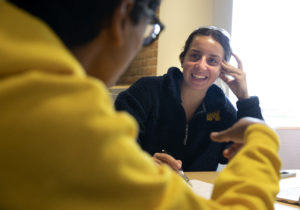
Jessica Kennedy (center) and Avinjoy Das discuss an informational sign they will design for a mechanism to secure wheelchairs on a bus. Photo by Marcin Szczepanski
“The current way we engineer is not people-centered. This course is changing that. I want students to believe they can make an impact in society using engineering. We are working on changing the make-up of the engineering community by improving retention and impact of engineering education on diverse designers/makers” says Dr. Austin-Breneman, one of the thought partners behind this particular course.
How exactly does a required course meant for all engineering students work to achieve such impressive goals? According to the team of instructors and thought partners for the course, this section is different in three fundamental ways: a focus on prototyping within the Socially Engaged Design Process Model; an agnostic approach to making and building; and an appreciation for humor and levity.
Prototyping within the Socially Engaged Design Process Model
With ENGR 100.750 filling the halls of C-SED each Wednesday, it is no surprise that the course was designed in collaboration with the C-SED staff to incorporate elements of the Socially Engaged Design (SED) Process Model. SED is a design process that incorporates social, cultural, historical, and political contexts into decision-making processes.. Additionally, the model also asks the designer to consider the impacts of their own assumptions, power, privilege, and identities when problem solving.
In the engineering industry, engineers are given problems to solve without being asked to consider the social impact of their decisions. Although engineers consider bodily safety when designing, societal harm is never considered and this discrepancy brings a host of unintended consequences.
“Engineers are not always taught to ask ‘should I be designing this?’ or ‘is this the actual problem?’. It’s important to understand why you are designing a solution and if it’s addressing the root causes and needs of the people who will be impacted by your solution” says Shannon Clancy, the Graduate Student Instructor for ENGR 100.750 and one of the C-SED Lab managers. ENGR 100.750 is changing that by encouraging students to reflect on themselves as a factor in the designing process.
This emphasis on reflection is both core to the SED Process Model and the ENGR 100.750 course. There is more of an emphasis on considering the purpose of engineering in general. Pushing students to contemplate all the potential impacts they could have in the world is more compelling than teaching them how to avoid getting fired.
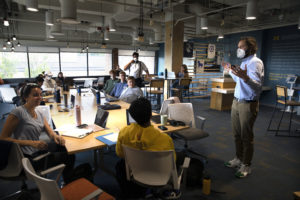
Philip Derbesy, Lecturer in the Program in Technical Communication discusses an informational sign students design for a mechanism to secure wheelchairs on a bus. Photo by Marcin Szczepanski
“Teaching that engineering can have a role in social impact is a good lesson for students to learn early and often. Socially Engaged Design goes hand-in-glove with what we are teaching them to be about engineers and communicators. Having a grander view of your work will make you a better engineer, coworker, etc.” says Philip Derbesy, PhD, a Lecturer III for Technical Communication within Michigan Engineering and the communication instructor for this section.
Approaching making and building agnostically
This course is a product of a grant Dr. Austin-Breneman received from the National Science Foundation’s (NSF) Improving Undergraduate STEM Education (IUSE) grant program along with collaborators at MIT who, as a group, are working on building more inclusive courses and makerspaces for students.
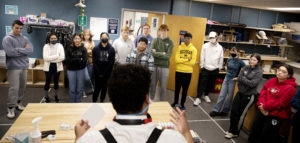
Jesse Austin-Breneman, Assistant Professor
At the Department of Mechanical Engineering at U-M speaks to his students in the C-SED lab.
Photo by Marcin Szczepanski
The goal with ENGR 100.750 was to introduce students to different kinds of making early on in their engineering career because within the Mechanical Engineering department, students are immediately introduced to precision machining as the preferred version of making. In this section, students learn more about low-fidelity prototyping. Low-fidelity (lo-fi) prototyping is a quick and easy way to translate high-level design concepts into tangible and testable artifacts. One of many methods of lo-fi prototyping demonstrated in the course prompt students to start with different types of foam and, using heat guns to manipulate the material, are asked to make something creative in the lab.
The instructional emphasis is not placed on making things perfectly, but simply experimenting with different ideas, techniques, and materials to see how it goes. The instructors encourage students to lean into the fun of building and reflect on the process.
Dr. Austin-Breneman, who is also an instructor for another Mechanical Engineering course with elements of machinery, knows that advanced forms of prototyping can be intimidating for young engineers because of the added complexity and danger. “I think a lot about how we can improve that experience for students. How can I make something that feeds into [that course] and make them feel more prepared? We are thinking specifically about marginalized identities (gender and race) because they are less likely to feel comfortable making/building in the engineering course.” reflects Dr. Austin-Breneman.
Shannon also remarks, “Making engineering less intimidating is especially important to those without pre-college engineering exposure which is also influenced by gender, race, socio-economic status, and other identities.”
Appreciating humor and levity
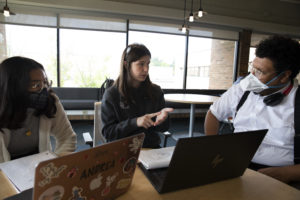
Jesse Austin-Breneman, Assistant Professor
at the Department of Mechanical Engineering (white shirt) and students Andrea Ouk_Gutierrez (first left) and Ally Buzard chat.
Photo by Marcin Szczepanski
Finally, Dr. Austin-Breneman, Dr. Derbesy, and Shannon are making their course a comfortable space using fun and humor. “It is just a lot of fun! Making this more inclusive sometimes looks like empowering them to make a lab playlist to play together while we all work.” says Shannon.
Dr. Austin-Breneman is intentionally whimsical and less formal while instructing as a way of making himself approachable and the space more welcoming. “Engineering as a discipline and how we train engineers is very rigid. All the exams and coursework are right or wrong and the more ‘right’ you are, the better you are. We are unlearning this. There is no right way to design.” he said.
With this in mind, the instruction team places more value on practicing engineering skills and methods, taking risks, and reflecting on the process as a whole. They start the semester off intoning to their students that the assignments and the exams are not what is most important, “what is the product or outcome we are looking for? No, the product is you! I don’t care about the assignment, I care about you learning from it!” recites Dr. Austin-Breneman.



